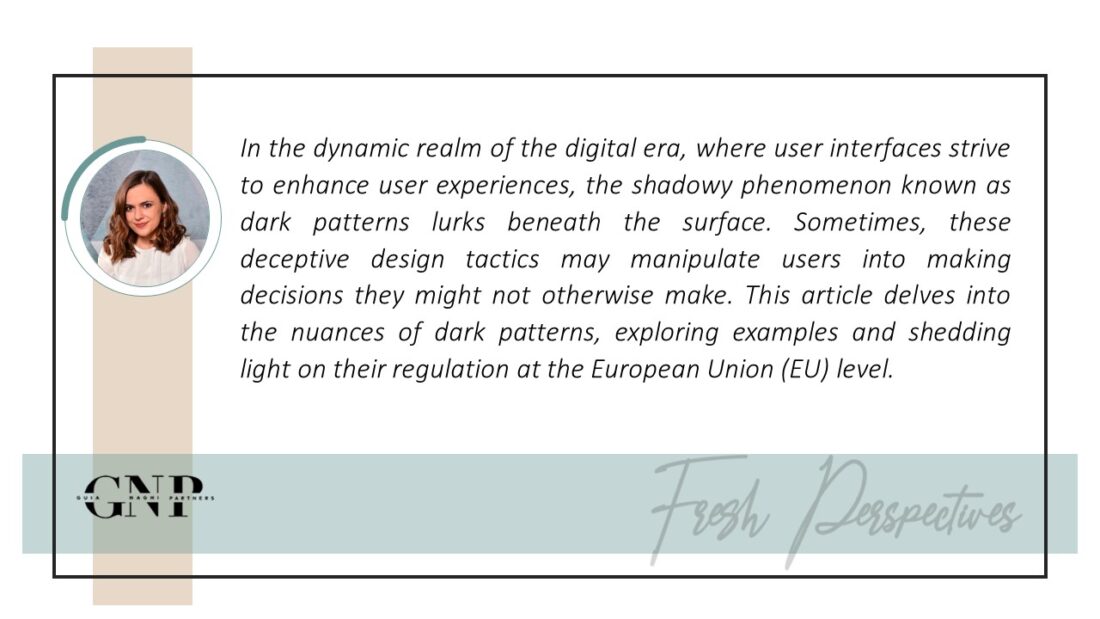Bianca Cernitoiu – Dark patterns – navigating the digital maze of deceptive design
Understanding dark patterns
Dark patterns emerge within the interfaces of websites and online platforms as deliberate or unintentional strategies causing notable distortion or impairment in the capacity of service recipients to make independent and well-informed choices. These tactics are often wielded to subtly guide users toward undesired behaviors or decisions, leading to unfavorable outcomes. The repercussions of dark patterns extend beyond mere inconvenience, exerting a profound impact on user autonomy and ethical standards. In essence, dark patterns are deceptive tactics that may mislead consumers using websites and apps, prompting them to make decisions they otherwise wouldn’t if presented with the complete context.
Common examples of dark patterns
Various types of dark patterns are currently employed to different extents by websites or apps as digital environments continue to evolve. A prevalent example is the notorious “Roach Motel” tactic, where users can effortlessly enter a situation but face exceptional difficulty when attempting to disengage. Specifically, it is often simpler for a user to create an account or register on an app than to delete that account or deregister.
Another deceptive practice involves hidden costs, surprising users in the final step of the checkout process with unexpected charges added to their order. This tactic is particularly cunning, as users are typically drawn in by a lower initial price, only to discover that the final amount they must pay is significantly higher.
Claims of artificial scarcity, suggesting a limited number of available products or a large number of other users watching the same product, may also fall under the realm of dark patterns. These tactics pressure consumers into quicker decision-making, often automatic and solely based on perceived scarcity. Similarly, the impact of fake reviews on consumer decisions is significant, given the growing reliance on consumer reviews and endorsements for purchasing choices.
The default settings of interfaces also wield a significant impact on the transactional decisions of the average consumer. Traders can not only influence consumers to take certain actions but also take specific actions on their behalf, such as using pre-ticked boxes. Further manifestations of dark patterns may take various forms, including infinite scrolls, deceptive ads camouflaged as different content, burying key terms, or the persistent prompting of unwanted messages.
Enforcement by EU Laws and competent authorities
The growing concern surrounding dark patterns has drawn the attention of both EU and national authorities, reflecting a collaborative effort to regulate the digital landscape for a secure and transparent online environment. Specifically, Regulation 2022/2065, widely recognized as the Digital Services Act (DSA), explicitly addresses dark patterns. The DSA prohibits online platform providers from creating interfaces that deceive or manipulate users, with the primary aim of preventing any distortion or impairment of users’ ability to make informed decisions.
It’s crucial to emphasize that dark patterns are not a recent development in the legal landscape. Competent authorities at both the European and member state levels have consistently confronted dark patterns, examining various types and formulating effective verification methods and sanctions.
From a legal standpoint, as dark patterns can be data-driven and personalized or implemented on a more general basis, they are also examined as practices that could potentially violate data protection and consumer protection rules.
In the realm of consumer protection, dark patterns are categorized as manipulative practices, frequently being labelled as misleading and unfair commercial practices employed by businesses concerning consumers.
The digital landscape is undergoing a transformative shift towards user-centric design and ethical practices. European authorities are proactively exploring mechanisms to encourage companies to embrace transparent and user-friendly interfaces, aiming to reduce the prevalence of dark patterns.





No Comments